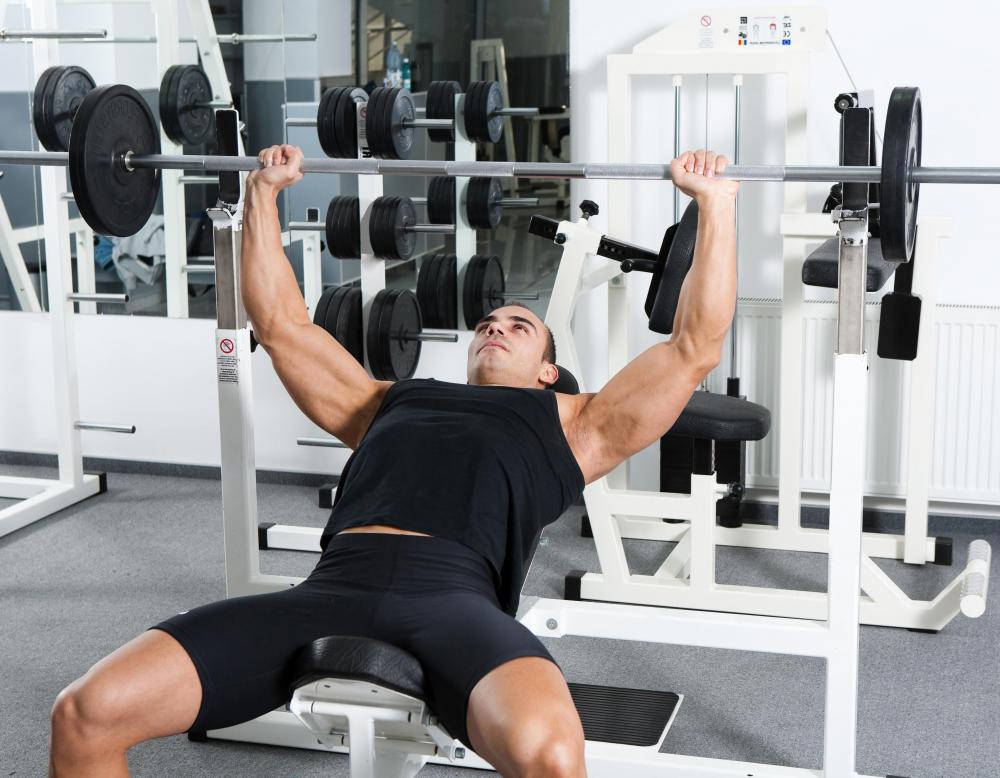At WiseGEEK, we're committed to delivering accurate, trustworthy information. Our expert-authored content is rigorously fact-checked and sourced from credible authorities. Discover how we uphold the highest standards in providing you with reliable knowledge.
What Is Muscle Failure?
Muscle failure is a body-building term used to describe the inability to complete one additional movement or repetition. There are three types of muscle fibers used to lift weight — type I, type IIA, and type IIB. The lowest classification, type I, is used to describe muscle fibers with a lower threshold for repeated movement. These fibers are typically exhausted first during heavy weight-lifting, leaving the higher threshold muscle fibers to take up the load. In this process, all fibers progressively weaken until muscle failure occurs.
Type IIA and IIB muscles generally grow much faster than low-threshold fibers. In traditional body-building, the higher threshold muscle fibers carry much less load as lifting repetitions are performed, no matter how weak muscles become during sets. If lower threshold muscles can carry the majority of weight throughout the set, the higher muscle fibers sustain little or no tearing. Tearing is necessary in body-building, however, for adding muscle mass.

The idea behind training muscles to the point of muscle failure is to work these higher threshold fibers. The process is similar to working over-time for muscles. For instance, if double the hourly pay rate was paid to an employee after eight hours of work, he would be more likely to work extra hours. Muscle failure is thought to work in much the same way. Muscles are worked until higher threshold fibers, type IIA and IIB, take over the weight load. These fibers offer faster gain, like over-time pay.

There are health concerns related to muscle failure workouts. As muscles fatigue, proper form may not be followed which can lead to injury and pain. Improperly warming up muscles and training to failure on a daily basis can also lead to muscle injuries. These injuries may be prevented with proper routine planning.
In order to work a muscle to failure, one weight lifter and two spotters, or assistants, are typically needed. A predetermined amount of weight is placed on a lifting bar. As the lifter presses to failure, the weight is removed but the set continues. This process is repeated until muscles are no longer able to lift even small amounts of weight, including the weight of attached body parts.

An example of a muscle failure workout could include beginning a bench press set with 225 lbs (about 102 kg) on the bar. When the weight cannot be lifted for one more repetition, 10 lbs (about 4.5 kg) can be removed from each side. The lifter can resume repetitions until muscle failure occurs again, and the process is repeated until no weight is left on the bar.
Does Going To Failure Build Muscle?
The value of training to failure is a controversial topic. Some experts believe it helps. Some believe it is essential. However, others believe it doesn't work any better than other techniques. Training to failure is generally more beneficial than doing easy workouts because for muscles to grow larger, they must be challenged with heavier weights.
The effectiveness of training to failure is difficult to judge because many studies on the technique do not ensure that the subject has reached failure. However, a few studies have been conducted that ensured that the failure group trained to failure and that both groups did the same number of reps.
Two such studies found that the failure group had higher levels of muscle activation but did not gain any more muscle or strength than the group that trained to the point of volitional fatigue. However, researchers noted that the subjects were all untrained lifters which may have accounted for the lack of difference.
A separate study of trained lifters found that the group training to failure performed worse than the group training to fatigue. There are two reasons this may have happened:
1. Diminishing Returns
The physiological changes that occur when pushing the muscle cells during lifting happen when the cell is close to its limits. Any additional benefit from reps performed after this point may be small.
2. Training To Failure Is Hard on the Body
Studies have found that training to failure causes disproportionately more soreness, fatigue and wear and tear on the body than training to near-failure. Lifters who frequently train to failure may have difficulty performing an optimal volume and intensity of sets which may impede progress.
Finally, another study reviewed the results of eight studies on training to failure and found that training to failure produced no significant difference in strength versus not training to failure. Because scientific research on the subject is limited, these studies are not conclusive proof. However, the evidence suggests that while training to failure does build muscle, the technique may not be significantly more beneficial than training to near-failure.
Do You Have To Train To Failure To Build Muscle?
The short answer is no. Training to failure can help you build muscle but so can other techniques.
Can One Set To Failure Build Muscle?
The value of single-set versus multiple-set training is another controversial topic. Research suggests that muscles must be worked beyond their current capacity to produce an increase in size and strength. Some experts believe that fatiguing your muscles is the only thing that matters and it doesn't make a difference if you do that in one set or multiple sets. Others believe that multiple sets produce greater gains.
Studies have found that while single-set training can provide benefits for experienced lifters, it is not as beneficial as multiple-set training. Beginners may see better results from single-set training than experienced lifters. However, the effects may be short-lived. The bottom line is that you can build muscle by performing a single set to failure; however, research suggests that you will get better results over the long term by doing multiple sets, particularly if you are an experienced lifter.
What Is the Difference Between Technical Failure and Absolute Failure?
Absolute failure describes the point at which the lifter is not capable of lifting the weight. Technical failure is the point where the lifter can no longer lift the weight while maintaining proper form.
When Is Training To Failure Beneficial?
While training to failure has drawbacks it does have some benefits. First, training to failure helps ensure that you are challenging your muscles during your workouts. One reason some lifters plateau is that they fail to keep increasing the difficulty of their workouts. Second, training to failure helps you assess your progress. Occasionally training to failure helps you measure your strength gains.
How Can I Effectively Use Training To Failure?
Because the benefits of training to absolute failure may not outweigh the risks, you may benefit more from training to technical failure. This reduces the chance that you will injure yourself by attempting to lift with poor form. Limit your training to technical failure to once every two weeks and two to three sets per workout. This helps ensure that the extra recovery your body needs doesn't make the rest of your program less effective. Avoid training to failure on exercises that involve complex movements, such as deadlifts, power cleans, overhead squats and good mornings. Training to failure makes it more difficult to maintain your form and losing your form on these exercises could result in serious injuries.
AS FEATURED ON:
AS FEATURED ON:













Discuss this Article
Post your comments